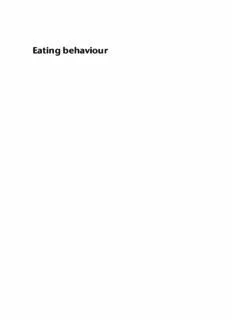
Eating behaviour PDF
Preview Eating behaviour
Eating behaviour Eating behaviour Terence M. Dovey Open University Press McGraw-Hill Education McGraw-Hill House Shoppenhangers Road Maidenhead Berkshire England SL6 2QL email: [email protected] world wide web: www.openup.co.uk and Two Penn Plaza, New York, NY 10121-2289, USA First edition published 2010 Copyright © Terence M. Dovey 2010 All rights reserved. Except for the quotation of short passages for the purpose of criticism and review, no part of this publication may be reproduced, stored in a retrieval system, or transmitted, in any form or by any means, electronic, mechanical, photocopying, recording or otherwise, without the prior written permission of the publisher or a licence from the Copyright Licensing Agency Limited. Details of such licences (for reprographic reproduction) may be obtained from the Copyright Licensing Agency Ltd of Saffron House, 6–10 Kirby Street, London EC1N 8TS. A catalogue record of this book is available from the British Library ISBN-13: 978-0-33-523583-4 (pb) 978-0-33-523584-1 (hb) ISBN-10: 0335235832 (pb) 0335235840 (hb) Library of Congress Cataloging-in-Publication Data CIP data applied for Typeset by RefineCatch Limited, Bungay, Suffolk Printed in the UK by Bell and Bain Ltd, Glasgow Fictitious names of companies, products, people, characters and/or data that may be used herein (in case studies or in examples) are not intended to represent any real individual, company, product or event. This book is dedicated to Chin Won Khoo Contents List of figures and tables xi Acknowledgements xiii 1 Introduction: widely held assumptions and methods 1 Widely held assumptions about food and eating 2 Scientific methods of eating behaviour research 5 Qualitative approaches and case studies 6 Psychometrics 7 Visual analogue scales and Likert scales 9 Measuring food intake 11 Food diaries 11 Feeding participants 12 Measuring total food intake 14 Within-meal measurements 14 The scope of this book 16 2 The energy demands of the brain: central mechanisms of eating 18 Introduction to appetite regulation 18 Historical development 19 The satiety cascad e 21 The central control of eating behaviour 22 Hypothalamic control of eating 22 Brainstem and cortical control of eating 28 Liking 30 Wanting 32 Sensory-specific satiety: how ‘liking’ and ‘wanting’ stop us eating 34 Summary 36 3 Storage and digestion: peripheral mechanisms of eating 37 Gastric phase 40 Intestinal phase: duodenum 40 Intestinal phase: jejunum 41 Intestinal phase: ileum 41 viii CONTENTS The effect of macronutrients on peripheral hormones 42 Responding to protein (amino acids) 43 Responding to fat (lipids) 43 Tonic signals: adipose tissue 44 Summary 45 4 Learning about food: developmental aspects of eating behaviour 46 Children and the development of eating behaviour 46 Cognitive development 47 0–2 years and the importance of exposure 48 Associative learning theory 49 Social learning theory, scaffolding and the influence of significant others 53 2–6 years and the development of food neophobia 54 Category representations of food 56 6–12 years and ‘picky/fussy’ eaters 58 12–16 years and the development of food-related cognitions 59 Summary 61 5 Choosing between foods: cognitive aspects of eating behaviour 63 Differentiating foods based on energy value 63 Memory and meals 65 The model of matching 65 Optimal foraging theory 68 Expectancy–value models 70 Food choice and ideology 72 Food choice and t he context of the eating episode 74 Portion size 76 Summary 78 6 The effect of others: social aspects of eating behaviour 79 Eating within a wider social context 79 Social approaches to food intake 80 Extending food choice into the social world: attitudes, norms and control 81 Social situational factors: the effect of others when eating 87 Social facilitation 88 Modelling 89 Impression management and social judgement 90 Media influences 92 Body image 94 CONTENTS ix Cultural/religious impacts on eating behaviour 97 Summary 98 7 Getting inside people’s heads: restraint, emotional eating, disinhibition and their combined effects 99 Dietary restraint 100 Emotional eaters 104 Disinhibition 105 External eaters 106 Combined effects 108 Escape from self-awareness theory 108 Limited capacity theory 109 Summary 110 8 Dealing with obesity: dieting and drugs 112 Defining obesity 113 Causes of obesity 115 Consequences of obesity 119 Treatments for obesity 122 Pharmacological treatments for obesity 123 Surgical treatments for obesity 124 Nutritional treatments for obesity – dieting 126 Physical activity interventions for obesity 128 Psychological treatments for obesity 129 Preventing obesity 132 Summary 133 9 When eating behaviour goes wrong: anorexia nervosa, bulimia nervosa and eating disorders not otherwise specified 136 What constitutes an eating disorder? 136 How common are eating disorders? 137 The causes of eating disorders 141 Organic causes of eating disorders 142 Non-organic causes of eating disorders 145 Consequences of eating disorders 152 Are all eating disorders similar? 152 (Sub-)types of eating disorders: anorexia nervosa and under-consumption 156 Restrictive type and binge purging type 156 Atypical anorexia nervosa 157 Anorexia athletica 157 Cachexia or cancer-related anorexia 158 x CONTENTS Child-onset and adult-onset anorexia 158 Orthorexia nervosa 159 (Sub-)types of eating disorders: bulimia nervosa and over-consumption 159 Purging type and non-purging type 159 Night-eating syndrome 159 Sleep-related eating disorder 160 Treating eating disorders 160 Interpersonal psychotherapy 160 Cognitive behavioural therapy 161 Family therapy 163 Pharmacotherapy 164 Full-time inpatient clinics 164 Summary 166 10 Tying up loose ends: towards a combined theory of eating behaviour 167 What we have covered in this book 167 Towards a combined model of eating behaviour 170 Conclusions 172 Appendix 1: The neurochemistry of appetite regulation 174 Appendix 2: Hormonal control of appetite regulation 180 Further reading 185 References 188 Index 222
Description: